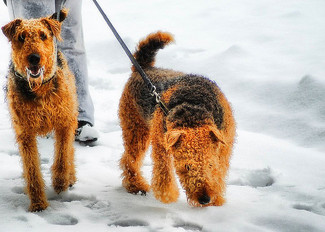Outdoor adventures with your dog can be safer and more fun with a little preparation

flickr photo by mysza831
Protecting a pet's paws when winter comes is of obvious importance. Whether one uses something like Musher's Secret or booties, the one on the other end of the leash needs consideration, just as much as humans do, to be comfortable and safe.
The snowy mess outdoors is a consideration when it comes to our feet for obvious reasons — we want to stay warm and dry.
Unlike our four-legged friends, being a biped poses a challenge trying to walk on snow- and ice-covered areas, and the risk of injury from a fall increases greatly this time of year. If you’re walking a dog, your risk of a slip and fall in winter conditions is even higher.
Being safe and smart when you’re enjoying the winter weather with your dogs on or off leash is a must.
For myself, there is one key tool in staying safe this time of year: the proper footwear.
Nothing beats my Betty Boots by Keen to keep my feet protected from the elements, and my ice cleats give me extra traction in winter weather. I frequently go from a wet sidewalk to snow-covered trail to icy country roads in rapid-fire succession, and can do so with more confidence because of what's on my feet. Click here for several types of gear to consider when it comes to getting good traction on winter walks.
But footwear is only one part of the equation when it comes to being safe while out walking your pet.
The other part of winter safety on dog walks is quite simply, the dog.
Case in point: when I'm out on daily walking rounds, all too often I see people struggling with their dogs, trying to get them not to pull, to listen to commands and to maintain an even cadence. In more than one instance, I’ve seen the human get knocked off of his or her feet because of slick surfaces and unruly pooches — a pretty dangerous situation where the consequences are not limited to a possible injury to the human and the dog.
In one instance, said dog became physically separated from the human and ran off in all of the confusion. Luckily, the pooch was easily coaxed back to the owner, and all was well.
Rule number one: each dog must listen to the commands of its partner on the other end of the leash.
Don’t get me wrong. When I’m out with my charges, it’s really all about fun. I’m there to get them out for exercise and a good time — a chaperone, of sorts. Reading and leaving 'pee-mail' is par for the course and exceptionally good for canines, as is exploring things along the way — within reason of course.
The difficulty begins though, when the pooch you're with must constantly pull or tug, or when they yank on the leash when you’re trying to clean up after they've done their business.
If your furry friend is having trouble getting the message about what you expect when he is out and about, I can offer a little wisdom to help you persuade your pup — no matter the age — to behave a little more politely on a leash, and advice on basic walking tools that will keep both of you safe this winter.
Ditch the retractable leash. Your dog should be able to walk politely on a traditional leash before you ever consider using a retractable. (I use a six-foot one most often.) Unruly dogs can get wrapped around trees or snarled in bushes and are not easily controlled when on a leash like this. Worst case scenario: These types of leashes do snap easily, and that's last thing you want.
Teach your dog to "sit/wait" when you're cleaning up after it. This command is invaluable in so many situations, but it's especially handy when you're trying to pick up their waste. I often offer dogs a treat to munch on to keep them occupied while I quickly scoop.
Consider buying a harness. There are many new items on the market to help making walking with your dog more enjoyable, and by clicking here, you can see an example of what is actually a dangerous idea. I provide body harnesses for dogs when they're in my care, as they are securely tethered to me once it's attached to the leash — no worry of them slipping out of a collar and taking off. A secondary benefit: when using a harness that uses a front-chest leash attachment like the Easy Walker from Premier, if the dog pulls, the harness tightens slightly across their chest and shoulder blades, (as opposed to their neck) and redirects their attention back toward you. I've used them on dogs that normally would pull constantly, and they get the idea quickly that pulling isn't a favorable thing, especially when coupled with teaching the next concept.
Loose leash walking — or walking without pulling — is a must. It doesn’t matter if you're on a sidewalk, on a desolate dirt road or on a hiking path. It's quite simple to teach, although I will admit it does take time to do. The key is consistency and patience, just like when you're working with your dog on basic obedience. Dogs learn best when those two elements are part of any routine. Knowing basic commands is so important for a dog and really should be taught alongside walking on a leash with manners. Click here for one of the best tutorials I've seen; it employs an effective positive reinforcement method for loose leash walking.
With a little preparation and effort on your part, your outdoor adventures with your pet can be safer — and more fun, just as it should be
Lorrie Shaw leads the pets section for AnnArbor.com. Catch her daily dog walking and pet sitting adventures or email her directly.

